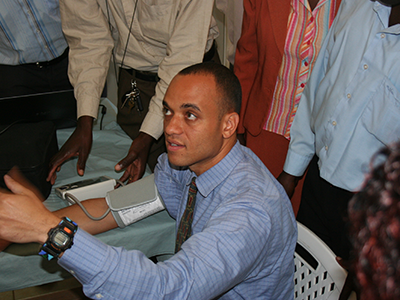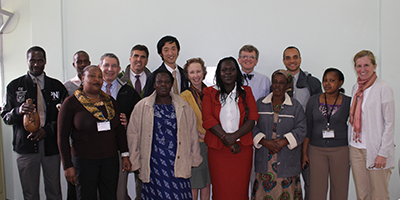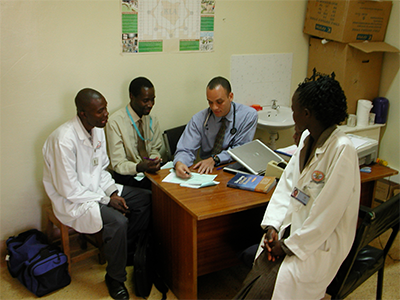
Gerald Bloomfield, MD, MPH, associate professor of Medicine, is a leader in cardiovascular global health research dedicated to combatting heart disease in under-served areas of the United States and in low to middle-income countries.
“My early ideas of medicine were about having a skill and knowledge that I could use to help other people. Medicine isn’t the only way to do that, but it was the way that resonated with me as a kid,” Dr. Bloomfield said.
Dr. Bloomfield is the associate director for research at the Duke Global Health Research Institute where he leads research and funding initiatives. It’s where he combines his passions for cardiology and global health research.
“I've known since I was in grade school that I wanted to be a doctor,” he said. But it was his grandmother, a nurse, who inspired him to pursue medicine. His parents gave him a view that put the world at center stage.
“My parents immigrated to the US from Jamaica, and I always had the perspective that the issues that we’re dealing with today aren’t only happening where we live, they’re happening all over the globe,” he added. “Having seen medical care delivered in places with less resources than we have in the US, I was interested in doing the same for other areas like that,” he said.

After graduating from Johns Hopkins School of Medicine, completing its internal medicine residency, master of public health programs and chief residency, he was admitted to Duke University’s School of Medicine’s cardiovascular fellowship program, and later, Duke’s Global Health Residency-Fellowship Pathway and the Fogarty International Clinical Research Fellowship. As a fellow, he got the opportunity to spend one year treating patients in rural Kenyan clinics.
“Heart disease, historically, in Kenya was always a terminal diagnosis. There was no expert to treat hypertension, a heart attack, or stroke,” Dr. Bloomfield said. “What really stuck with me was the fact that patients did not have a general knowledge around cardiovascular disease. The health literacy around heart disease was almost non-existent.”
To deliver the best care, he gained the trust of the community by actively listening to their concerns and educating them in Swahili about chronic conditions like high blood pressure. “I really wanted to hear what the needs are, and then figure out if our team are the right people to address those needs,” said Dr. Bloomfield.
Most traditional cardiac fellowship programs didn’t include the opportunity to gain skills to be used specifically in under-resourced populations but spending a year of his cardiology fellowship learning and practice medicine and research in Kenya, closed the gap in training for Dr. Bloomfield.
Providing Care and Leading Research in Kenya

Afterward, Dr. Bloomfield and his family began spending six months out of each year in Kenya, and the other six months in North Carolina, which was supported by a career development award from Fogarty International Center. During that time, he launched a clinical research program to determine the causes of heart failure among East Africans at the Moi University School of Medicine, in Eldoret, Kenya.
From there, he, along with several mentors, established the Cardiovascular and Pulmonary Disease Center of Excellence at the University, which led to the development of the Moi Teaching and Referral Hospital-Duke Cardiovascular Fellowship Program, and the construction of a cardiac care unit.
He conducted research projects, mentored Kenyan physicians, and trained nurses and sonographers to perform heart procedures, echocardiograms (EGC), and ECG readings. Dr. Bloomfield instituted didactic talks, educational lectures, and served as a cardiac consultant in the hospital.

“When people saw others getting better, they started coming to the hospital on death’s door, and we were treating them and sending them home after they improved,” Bloomfield said.
As demand grew, more senior cardiologists were brought in to care for patients and mentor future clinicians, creating a new opportunity for Dr. Bloomfield. He discovered a passion for mentorship, a role he developed over time, and now leads with a specific approach.
“My overall approach to our training program has always been to listen first. When we're seeing patients in clinic and hearing their stories, it applies to our research and what the community needs are,” he said.
After handing over the reins to Kenyan leaders, and with Duke doctors visiting intermittently, Dr. Bloomfield now only returns to Kenya two-three times a year to advise on the future growth of cardiac care and research. “The programs there are essentially sustaining themselves, and we get to collaborate on a higher level” he said.
Research in the US
Dr. Bloomfield is now bringing the lessons he’s learned abroad to the U.S. health care system. “Although the language and some details may be different, the issues around delivering high quality care to people who are sick and don’t have access to the resources they need, are very similar in many parts of the world, including in the U.S.,” he said. “Global includes international and domestic. We need global health approaches in the U.S. as well.”
He is currently working with a team of experts to address cardiovascular health in rural areas. Cardiovascular disease is the leading cause of death in the U.S. and accounts for every one in four deaths globally. Rural areas experience 60,000 more deaths than urban areas yearly due to limited access to health care providers and resources. Most rural hospitals don’t have specialists or the cardiac imaging machines required to detect, diagnose, and manage cardiovascular disease.
To combat this, Dr. Bloomfield is co-leading the Echocardiography Core Lab on the mobile examination unit for the Risk Underlying Rural Areas Longitudinal (RURAL) Study. It’s an ongoing population-based cohort study that helps physicians identify risk factors for heart and lung diseases in rural counties in Alabama, Kentucky, Louisiana, and Mississippi that have higher cardiovascular disease death rates than the rest of the country.
“We are bringing early diagnosis to individuals,” he said. The mobile examination units are outfitted with a lab, private exam rooms, and cardiovascular assessment and imaging tools. “We’re seeing community volunteers and assessing their heart health. Then we’re following them over time to figure out how we can prevent heart disease or treat it better in the future,” he added.
Dr. Bloomfield ensures the echocardiograms are performed correctly and then the scans are sent to Duke for analysis. Unlike similar studies, the results are returned to participants and shared with their doctors if abnormalities, like signs of heart failure, are found.
More than 3,000 participants have been enrolled in the study. The team engages with community leaders first and then hosts a free day for residents to tour the truck and get familiarized with the study. Researchers are comparing the data they gathered and comparing it to four counties that have lower cardiovascular disease rates.